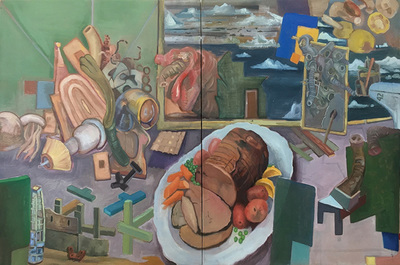Trunks and Tales: Stuart Diamond

Stuart Diamond, Memory and Puzzles, 2016, oil on canvas, 40 x 60″.
Stuart Diamond remembers the excess of the 1980s. Then a young painter submerged in the seeming infinity of the New York art world, he recalls that, “Nuance wasn’t quite part of the dynamic back then…The word ‘composition’ was taboo when I was in art school.” Now, in his latest body of paintings Trunks and Tales, Diamond applies a subtler “fresh strategy” to the traditional genre of still life, drawing on his invigorating lineage of second- and third-generation abstract expressionism.
Employing both extravagance and restraint, Diamond serves up bizarre casseroles of culinary, zoological and amorphous imagery: sandwiches, whales, ziti, crackers, carrots, lumber, pot roasts sourced from vintage Betty Crocker cookbooks, dissected chunks of elephant and grinning, disembodied ox muzzles. Diamond says a motif of a green cleaver acts as “an accordion device moving through the work.” This recurring character is an avatar of division, slicing up space and ushering in multiple perspectives.
A keen interest in color led Diamond to pursue food as imagery. An abstractionist at heart, he hopes the coloration hits the viewer’s gut before their thoughts. “Color lets you feel something before you intellectualize it,” Diamond says. Opaque, mostly flat hues encourage the viewer to digest these paintings carefully, whether by feeling, cogitation or some combination thereof.
Diamond seeks a direct and unfussy draughts-manship, the brand seen in the work of Giorgio Morandi. He paints not illusionistic, dimensional space, but layered realms, as if collaging elements or compositing animation cels. His representational forms are correspondingly cartoonish—not unlike the elastic, rubbery figures of Peter Saul, albeit without the fluorescent palette or incendiary sentiment.
Indeed, if Saul is an avuncular prankster, Diamond is a riddler, a puzzle maker. The architecture of his paintings is unplanned, an organic venture to be untangled by both painter and audience. Inevitably his compositions display an engrossing spatial logic: a collision of worlds, occupied by a menagerie of forms to be seen from numerous vantage points. “I don’t want to know what the conclusion is,” Diamond says. He prefers the paintings to be “less readable,” intelligible to a point but teetering always beyond the fully comprehended.
